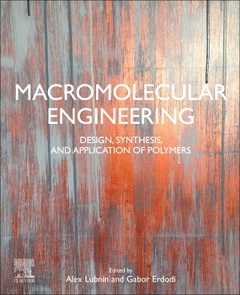Description
Macromolecular Engineering
Design, Synthesis and Application of Polymers
Coordinators: Lubnin Alex, Erdodi Gabor
Language: English
Subjects for Macromolecular Engineering:
Keywords
AB block copolymers; AB-PBI; ABA triblock copolymers; adhesion; ADMET; aliphatic polyesters; alkoxybenzene; amphiphilic conetwork; band gap; barrier properties; biocompatible; biomaterials; biomimicry; block copolymers; butyl rubber; cationic polymerization; coating; conjugated; crystalline melting point; dispersions; donor-acceptor; drug-eluting stent; effect of reaction conditions; electrophilic polymerization; end-quenching; Friedel-Crafts alkylation; functional polymer; functionalized polymers; glass transition; glass transition temperature; glaucoma; heart valves; hydrophobicity; hydrophobizing microemulsions; inclusion complexes; intraocular lens; ionomers; living carbocationic polymerizations; macroinitiator; microshunt; molecular composites; multi-mode polymerization; multifunctional cationic initiators; mussel; nanocatalysis; nanohybrid; organomodified silicone; PDLA; PEEK; PEK; PEKK; permeability; PLLA; poly(styrene-block-isobutylene-block-styrene); poly(vinylidene chloride); poly(vinylidene fluoride); polyamide; polyisobutylene; polymer; polymer solar cells; polyol; polyurethane; PTFE; quasiliving polymerization; radical polymerization; readily biodegradable; ring-opening polymerization; segmented macromolecules; SIBS; star-branched polymers; structure-property relationship; sum frequency generation; super-hydrophobicity; surface drying; surface protection; Suzuki polycondensation; symmetry; TAVR; TAXUS; telechelic polymer; thermoplastic elastomers; urethane; waterborne; wound closure
310 p. · 19x23.4 cm · Paperback
Description
/li>Contents
/li>Biography
/li>Comment
/li>
Macromolecular Engineering: Design, Synthesis and Application of Polymers explores the role of macromolecular engineering in the development of polymer systems with engineered structures that offer the desired combination of properties for advanced applications. This book is organized into sections covering theory and principles, science and technology, architectures and technologies, and applications, with an emphasis on the latest advances in techniques, materials, properties, and end uses ? and including recently commercialized, or soon to be commercialized, designed polymer systems. The chapters are contributed by a group of leading figures who are actively researching in the field.
This is an invaluable resource for researchers and scientists interested in polymer synthesis and design, across the fields of polymer chemistry, polymer science, plastics engineering, and materials science and engineering. In industry, this book supports engineers, R&D, and scientists working on polymer design for application areas such as biomedical and healthcare, automotive and aerospace, construction and consumer goods.
Theory: New Platforms 1. The puzzling role of symmetry: A tool for macromolecular engineering
New Polyisobutylene Science and Technology 2. End-functional polyisobutylenes by quasiliving carbocationic polymerization: bi- and multicomponent architectures 3. Multifunctional initiators for isobutylene polymerization 4. New polyisobutylene-based polymers through Friedel-Crafts alkylation Chemistry 5. Polyisobutylene-assisted multi-mode polymerization and molecular composites
New Architectures and Technologies 6. Tailor-made polymers for industrial and household applications 7. The properties and applications of polyamide-based polyurethanes 8. Electrophilic polymerization for specialty plastics 9. Segmented conjugated macromolecules 10. Aliphatic polyesters with novel architectures by ring opening polymerization
Disruptive Medical Applications 11. The use of poly(styrene-block-isobutylene-block-styrene) and analogues for long-term implant applications 12. Polyisobutylene to the rescue: Advanced elastomers for healthcare
Industrial Applications 13. Role of hydrophobicity in underwater adhesion
Dr. Erdodi holds a Ph.D. in organic chemistry which he received working under the guidance of professor Bela Ivan in Hungary working on living polymerization of polyisobutylene and amphiphilic conetworks.
He worked at the University of Akron on macromolecular design by living polymerizations, biomaterial projects, including the development of membranes for bioartificial pancreas, polymers for contact lenses, and polyurethanes.
Dr. Gabor Erdodi has been working at Lubrizol Performance Coatings for 8 years in new product development. He invented polyamide-based polyurethanes, which is a novel polyurethane type and created a technology platform with a rapidly growing family of new products. Dr. Erdodi is the author of 30 scientific publications in peer reviewed journals, and inventor in 26 issued patents
- Presents the theory, principles, architectures, technologies, and latest advances in macromolecular engineering for polymer design and synthesis
- Explains polymer design for cutting-edge applications areas, including coatings, automotive, industrial, household and medical uses
- Approaches several novel materials, such as polyisobutylene (PIB), polyamide-based polyurethanes, and aliphatic polyesters
These books may interest you

Plastics Technology Handbook 353.44 €



